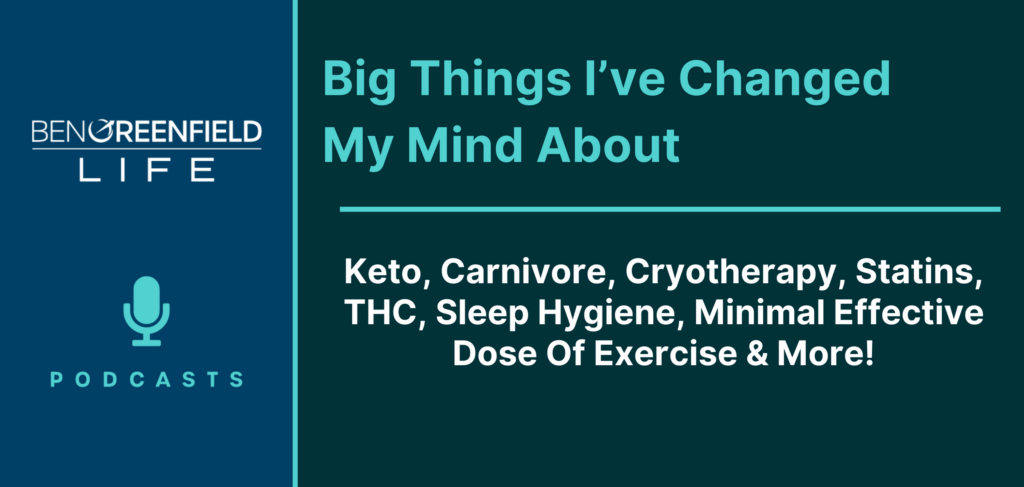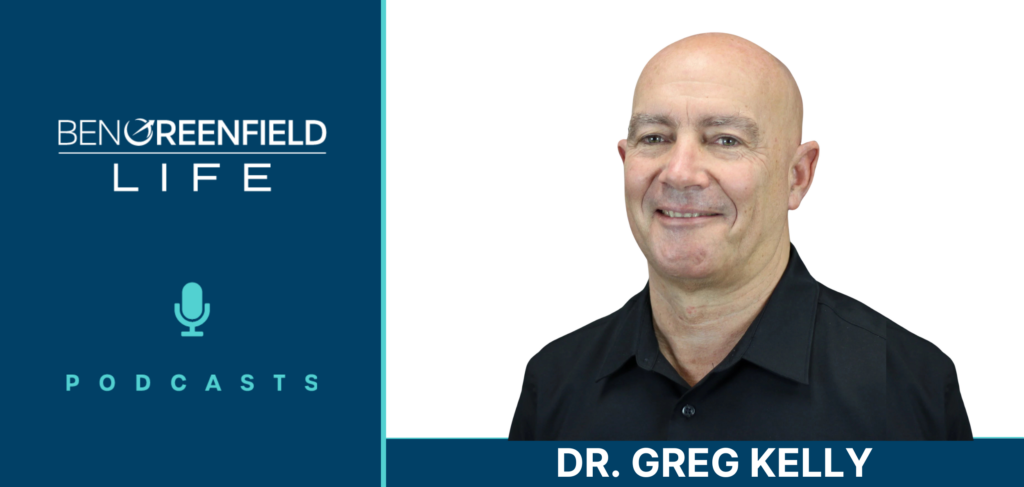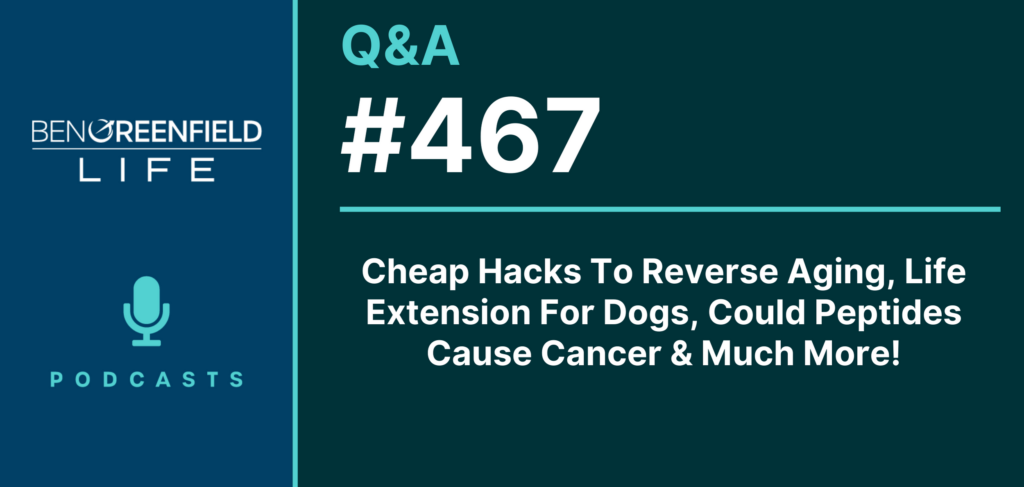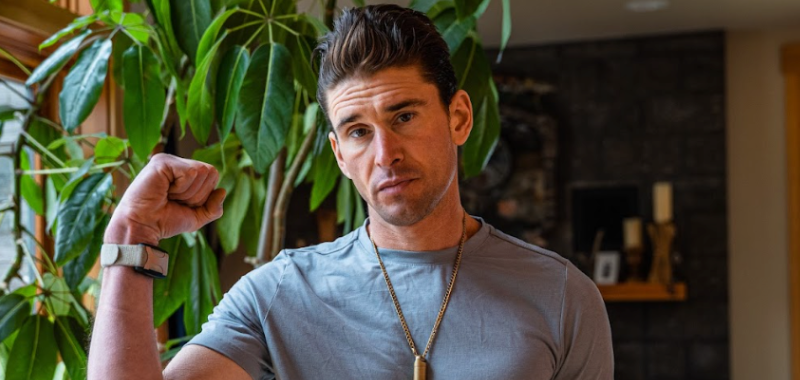June 29, 2021
Back in April, I announced that I would be embarking on a months-long hair growth project, that seems to have also sprouted (heh) into a beard growth project too.
If you've been following me on Instagram, you've no doubt noticed that I do in fact already have a full head of hair…but now it's fast becoming a veritable lion's mane.
…so why on earth would I dedicate this much time and effort to the subject?
Here's why: we're talking about a problem of epic proportions. Hair loss can cause effects akin to emotional trauma, and it plagues millions of people. Fact is, you can go “all-in” with eating the right foods, optimizing your sleep, powering your workout, and even dedicating yourself to spiritual growth, but if your self-confidence is tanked thanks to a receding hairline, you're not going to feel great.
When I made the hair growth project announcement on Instagram back in April, the response was overwhelming and confirmed that hair loss is a subject worthy of the time I'd planned to invest. Nearly 7,500 of you “hearted” that post and the questions and comments started pouring in. Since then, I've kept you posted on Instagram (here and here and here) and I'm going to continue to do so.
Last week, I took the project to another level with a podcast with my friends Jay Campbell and Nick Andrews of Entera. Jay and Nick are upending current thinking on hair loss reversal with Entera, their revolutionary science-backed cosmeceuticals company. (I also talked hair loss and anti-aging on this recent podcast with Dr. Cameron Chesnut.)
The entire multi-billion-dollar hair loss industry is currently predicated on the theory that DHT—a sex hormone directly derived from testosterone—is responsible for hair loss and that inhibiting DHT is the answer for stopping hair loss and initiating hair regrowth. Jay and Nick are loudly challenging this theory, and provide a wealth of evidence of its fallacy as a fix in this article I asked them to write that I published last week.
In the article, Jay and Nick continue to explain in detail the 5 major flaws of the DHT inhibition theory and, once you read this article, I don't think there will be any doubt in your mind that the theory just doesn't hold up. And if it wasn't bad enough that you may be spending thousands of dollars on a treatment that is ineffective, said treatment is in fact quite harmful to your health. In last week's article, Jay and Nick also outline 9 negative health effects of inhibiting DHT, including sexual dysfunction, fat accumulation, and depression. No thank you, right?
Then again, if you are one of the millions of people who suffer from the confidence-squashing effects of an ever-dwindling head of hair, it's possible that you're thinking that those risks may in fact be worth the infinitesimal chance that you will reclaim your locks.
Thankfully, you don't need to go there. In today's article, Jay Campbell and Nick Andrews present the second part of this two-article series in which they talk about what does work when it comes to putting a stop to hair loss and even generating hair growth. Enjoy!
9 Ways To Reverse Hair Loss (And Grow New Hair)
In last week's article—we (i.e. Jay Campbell and Nick Andrews)—explained why the DHT inhibition theory, while widely and arguably blindly accepted, is blatantly inaccurate.
However, it wouldn’t be prudent to dismantle the hair loss industry and end this series without providing viable solutions for you to take complete control of your hair loss problems.
So what's the answer?
Well, it turns out that it's more complex than a single theory or drug. Rather, the optimal way to stop hair loss and enhance regrowth (even if you have a genetic predisposition(s) to hair loss) is through the combined action of the following adjuvants, also known as “bioregulators” and discussed in detail in this recent podcast with Ben Greenfield.
Below, we break down 9 steps that you can take today starting today to address the problem of hair loss (and even regrow your hair)…
1. Living A Fully Optimized Lifestyle
Short of directly editing your genome, there are multiple possible causes of hair loss that can easily be fixed with mere lifestyle intervention. The key, as we covered in detail in Part 1 of this series, is to live a low-inflammation, fully-optimized lifestyle that includes proper sleep, vigorous exercise, clean nutrition, cutting out the obvious stuff (smoking, alcohol, sugar), and even using supplements such as colostrum, glutamine, and even metformin to clean up your gut health (which, by the way, does not compromise mitochondrial function, although you can read more about Ben Greenfield's more detailed views on metformin here). Yes, that's right, science has shown that even bad gut health can negatively impact hair follicle health!
Inflammation is your body's process of seeking to heal itself from damaging infections, injuries, and toxins. When this happens, your body releases chemicals that trigger a response from your immune system. Minor, acute inflammation serves a productive purpose, such as when you need to rest a sprained ankle. What's problematic, as noted above, is systemic inflammation.
Systemic inflammation does not result from a single event as an injury like that sprained ankle often does. Rather, chronic inflammation is more of a result of ongoing inflammation-producing activities and lifestyle choices. Physical activity has proven anti-inflammatory effects and may be particularly beneficial for older adults; a sedentary lifestyle is a major contributor to systemic inflammation.
Diet is also a primary factor, with foods such as refined carbohydrates, soda, and red meat (staples of the typical American diet) triggering inflammation, while foods such as olive oil, green leafy vegetables, and fatty fish work as anti-inflammatories.
Every clinician who knows their stuff will be the first to tell you that a heavily inflamed lifestyle reduces the effectiveness of conventional hair loss treatments. In all truth, systemic inflammation is the real culprit for most of the diseases of aging. The more inflammation-free and dialed in your health is, the faster your results will come and the better they will be over time.
2. Red Light Therapy In The Scalp
Ben has covered red light therapy in detail—including in this article and this article and on this podcast—because it's a powerful modality for healing scars and wounds, upleveling your sleep quality, improving skin tone and complexion, and much more.
So it's not entirely surprising that red light therapy could have a positive effect on the scalp—and now there are clinical trials showing fantastic results with red light therapy enhancing hair regrowth. One 2019 meta-analysis of 11 randomized controlled trials showed red light therapy was effective for treating androgenic alopecia and increasing hair density regardless of gender, duration of treatment, or the type of device used.
Multiple mechanisms appear to be at play:
“Evidence suggests that [red light therapy] acts on the mitochondria and may alter cell metabolism through photodissociation of inhibitory nitric oxide (NO) from cytochrome c oxidase (CCO) (Unit IV in the respiratory chain of mitochondria), causing increased ATP production, modulation of reactive oxygen species, and induction of transcription factors such as nuclear factor kappa B, and hypoxia-inducible factor-1.
These transcription factors in return cause protein synthesis that triggers further effects downstream, such as increased cell proliferation and migration, alteration in the levels of cytokines, growth factors and inflammatory mediators, and increased tissue oxygenation.”
In case you didn’t know, nitric oxide is a very potent vasodilator that increases blood flow. While the exact mechanisms are still being studied, red light therapy is unquestionably safe and worth incorporating into your regimen. (Ben gets his red light fix with panels from Joovv, and he has arranged a special discount with code BEN here if you're interested in a home device.)
3. Platelet-Rich Plasma (PRP)
Platelet-rich plasma (PRP) injections are one of the latest newcomers to the hair loss industry.
The way it works is simple: After blood is drawn into your arm, a centrifuge is used to spin the blood sample at such high speeds that you end up with a solution where PRP is in a separate layer from your plasma (blood). It is extracted and then used as a formula for injections into your scalp at several points.
The platelets themselves contain proteins such as VEGF (vascular endothelial growth factor) and TGF (transforming growth factor), both of which contribute to new follicular development and increased blood flow. Evidence supporting PRP injections is still emerging, but 3 human studies have found the treatment to increase the number of hair follicles on your head and improve overall hair thickness.
However, there are a few drawbacks to PRP injections:
- You need a new injection every 4-6 months for maintenance purposes
- Side effects appear to be minimal and only associated with those of a needle injection (redness and itching at the site of injection), but more data may reveal other unwanted long-term adverse events
- Each individual PRP injection can cost several hundreds of dollars (but see below for an opportunity to save there)
- Your health insurance provider likely won’t cover it
- The studies published so far only target male pattern baldness, and there has yet to exist a “standardized” PRP injection treatment (i.e. different frequency of injections and time between each one, different PRP preparations, etc.)
If you’re willing to face all the possible downsides, PRP might be worth a look. Speaking of faces, Ben and his wife Jessa recently did a platelet-rich plasma (PRP) facial treatment with Dr. Cameron Chesnut before an epic podcast with him, resulting in bloody faces that they took out on the town. (And if you're interested in a PRP treatment for yourself, including a telemedicine consult with Cameron, Ben mentions in that podcast you can go here for a special 25% discount.)
4. Exosomes for Hair Loss
This is yet another brand new area of exploration for treating hair loss, so treat it as such:
“Exosomes are extracellular vesicles of the smallest size, that act as cell-to-cell transporters and messengers by carrying signaling molecules including transcription factors, cytokines, and RNA.
Exosomes have been demonstrated as important modulators of paracrine signaling, and particularly, DP [dermal papilla] cell-derived exosomes could be of major importance for hair follicle regeneration.”
And indeed they have.
Thanks to the fact they are derived from stem cells and contain a wide variety of growth factors, exosomes already show great potential for effective hair loss without nasty side effects:
- Exosomes may “promote the development of hair follicles”
- Exosomes potentially “activate DP cells, prolonged survival, induce growth factor activation in vitro, and promote hair growth in vivo”
You will need one treatment every 6-8 months, and you will have to refrain from exercising for 24 hours post-treatment. Early evidence suggests exosomes can be used alongside and in addition to other hair loss treatments without compromised results. You can do a Google search to find a practitioner in your area, but be certain you are working with an experienced physician, get a thorough consultation first, and check references. Dr. Rob Kominiarek, a highly-respected practitioner at Renue Health in Ohio, collects medical records and laboratory results as part of the consultation process. Dr. Kominiarek attests that “a significant body of literature documents the anti-microbial and anti-inflammatory effects of exosome therapy, upregulating healthy, strong tissue regeneration of the scalp.”
5. PTD-DBM (The Hair Growth Peptide)
PTD-DBM is a peptide activating the Wnt/β-catenin signaling pathway. Wnt/β-catenin signaling is an evolutionary biological system pathway regulating key cellular functions, including genetic stability and stem cell renewal. By topical application, PTD-DBM seems to possibly promote the formation of new hair follicles and prevent hair loss.
Combining the peptide PTD-DBM with Valproic Acid (VPA)—a branched short-chain fatty acid—can further stimulate hair re-growth as well as induce hair neogenesis also understood as hair follicle regeneration.
This PTD-DBM peptide is without question a legit peptide for hair loss and regrowth as it stimulates the development of new follicles, but it does not resolve the central issue of micro inflammations and lack of blood flow to the scalp. This puts the longevity of any newly generated follicles in question. Because PTD-DBM doesn't address the underlying “starvation” of the follicle (leading to them dying off), it’s most likely just a temporary solution.
6. Dermarolling
Dermarolling (a.k.a. microneedling) is the act of using a dermaroller—a roller covered in small, fixed needles (usually 0.3 mm or smaller)—over the skin to create micropunctures. Dermarolling is another topic that Ben got into on his podcast with Dr. Cameron Chesnut (and on this podcast, too). Most of the time, dermarolling refers to micropuncturing the face, but logically the efficacy of the method extends to the scalp, possibly opening up hair follicles for more absorption, which would make it a great tool alongside any treatment you are directly applying to the scalp.
While we saw some evidence earlier in this article that scalp massaging techniques such as microneedling can improve blood flow towards the galea aponeurotica, the evidence to date suggests it’s not superior to existing treatments:
“This therapy is used to induce collagen formation, neovascularization and growth factor production of treated areas. It has been used in a wide range of dermatologic conditions, including androgenetic alopecia (AGA) and alopecia areata, among others.
While there are a limited number of studies examining this therapy in the use of hair loss, microneedling has been successfully paired with other hair growth-promoting therapies, such as minoxidil, platelet-rich plasma, and topical steroids, and shown to stimulate hair follicle growth. It is thought that microneedling facilitates penetration of such first-line medications, and this is one mechanism by which it promotes hair growth.”
While dermarolling probably should not be the first thing on this list you want to try, it certainly may help, and it's something you can even try at home with an inexpensive device.
7. Enhancing Mitochondrial Health
One of the easiest and most powerful ways to restore your mitochondrial health is to start drinking deuterium-depleted water. Ben is a proponent of this practice for a number of health reasons, as he discussed on this podcast with Dr. Anne Cooper and Dr. Que Collins.
In short, deuterium inhibits your mitochondria’s ability to produce adenosine triphosphate (ATP) and provides your body with the cellular energy it needs to function optimally. Combine that with the increasing link between mitochondrial dysfunction and age-related diseases, and you have a recipe for disaster.
If you go to this article, we’ll tell you about the best place to get deuterium-depleted water and how you can get your hands on it today. Although there are numerous strategies for boosting mitochondrial function (Ben has talked about this before), all you really need to do is follow the first recommendation and live a low inflammation lifestyle.
As already mentioned, metformin and/or dihydroberberine can significantly help your cause through improving microbiome function and suppressing systemic inflammation.
Finally, fasting and sungazing are free, effective ways to improve your mitochondrial health. Fasting improves mitochondrial function through the well-understood biological processes of autophagy and hormesis. Fast-adapted mitochondria learn to increase oxygen efficiency, reduce oxidative waste, and still maintain optimal ATP production.
Sungazing early in the morning (or even in the later hours before dusk) allows the skin to absorb infrared (IR) light. This enhances mitochondrial function and dopamine signaling which ultimately improves mood and increases energy.
Now, if you're ready for a bit of biohacking and better living (and hair!) through science, then keep reading, because we've also discovered two potent bioregulators that definitely fly under the radar but definitely also produce shocking results for hair thickness, hair growth, staving off hair loss, firm skin, reduction of wrinkles and much, much more.
The next two points, below, are arguably the strongest contenders for effective reversal of hair loss and growth of new hair…and the same peptides we discussed in our podcast with Ben.
8. GHK-Cu
A peptide is one or more amino acids linked by chemical bonds. GHK-Cu is a naturally-produced copper peptide that was discovered in 1973 by Dr. Loren Pickart, who is single-handedly responsible for bringing its wide range of health benefits into the public eye.
The “GHK” stands for “glycyl-L-histidyl-L-lysine,” making it a tripeptide (i.e. a peptide made up of 3 amino acids). The “Cu” stands for the copper ion that forms a complex with GHK due to the strong binding affinity of GHK towards Cu.
Both compounds on their own are vital to human health—GHK provides us with our regenerative capacity, while copper is responsible for vital biological functions such as regulating blood pressure and heart rate. Four decades of research demonstrate the ability of GHK-Cu to improve overall skin appearance and health, accelerate the healing of wounds, boost your immune system, and so much more.
Here are all the ways in which GHK-Cu can help you reverse hair loss:
- Lowers systemic inflammation in your body
- Increases blood flow to your hair’s follicular roots (i.e.it is angiogenic in that it allows new blood vessels to form via enhancing the delivery of oxygen and nutrients to the active tissue in the scalp)
- Prevents hair follicles from shrinking (if not enhancing their size)
- At a minimum, as equally effective as Minoxidil without any hair loss side effects shown by Minoxidil users upon discontinuation of use
Not to mention the risks associated with GHK-Cu are rare in frequency and very low severity, with side effects that generally disappear in 24 hours such as redness and itchiness.
9. C60
Carbon 60 (C60) is a spherical-shaped molecule consisting of sixty carbon atoms. Not only does it possess incredibly powerful antioxidant properties, but it shows great potential in increasing human lifespan. The discovery of C60 dates back to the 1970s when Eiji Osawa recognized its shape which was confirmed 15 years later via mass spectroscopy.
Although it would be many years after that C60 would be used in the context of improving human health, scientists were amazed at its extraordinary properties: even in extremely high temperatures and pressure, it easily maintains its rigid structure.
Not only does C60 possess incredibly powerful antioxidant properties, but it shows great potential in increasing human lifespan. Other less-studied outcomes include a faster metabolism, a slowed development of arthritis, and maximizing mitochondrial efficiency.
The studies are rather limited regarding hair growth, but so far it looks awfully promising…
One 2009 experiment with bald mice who consistently saw synthesis of new hair follicles and growth of hair, regardless of whether they were genetically predisposed to being bald or having been shaved bald prior to the experiment
A 2016 study of healthy Japanese men who reported 16% faster hair growth within six months after using a C60 formula applied to the scalp twice a day.
The most likely explanation for these results is C60’s ability to act as a molecular sponge to rid your body (and most importantly scalp) of harmful micro-inflammations (i.e. oxidative waste and free radicals).
When used in combination with GHK-Cu, the super anti-oxidative effect provided by C60 (acting as a molecular sponge) dramatically improves the shuttling of the GHK-Cu into the active and dormant hair follicles greatly improving angiogenesis while ultimately stimulating hair follicle regrowth.
How To Use Hair Growth Bioregulators
So how do you get reliable, effective GHK-Cu and C60 bioregulator therapies in a delivery mechanism that is consumer-friendly?
That was the question that we were determined to answer at our company Entera.
Ultimately, we created a product that is not only made to exceptional standards but with pure love.
Auxano Grow V2 is a revolutionary, patent-pending, at-home treatment you can use to reverse hair loss for good (via enlargement of shrinking hair follicles) while growing a shinier, thicker head of hair. It combines GHK-Cu and C60 into one dual phased patent-pending formulation that suppresses topical inflammation while simultaneously stimulating angiogenesis in the hair and scalp.
From the GHK-Cu side (Serum A) most of the products found in the marketplace are cheap and low grade with an extremely small % of GHK-Cu as the active ingredient if there is anything at all. (Do a general search on Amazon for GHK-Cu and you will quickly see what we’re talking about.)
Entera uses pharmaceutical-grade GHK-Cu at a 3% active ingredient level. When in pure microfine powder form it appears as a purple/royal blue glitter. Everything else in comparison will appear as a dull blue powder often smelling like solvent.
From the Carbon 60 side of things (Serum B), it is imperative the purity level of the C60 should be 99.99% and the carrier oil must be organic.
Both Serum A and Serum B work synergistically to improve follicular health while improving the condition of the skin surrounding the follicles. Auxano does not interfere with DHT production (or any hormonal systems). There are no injections needed, no nasty side effects, and no lifetime dependency.
Amazingly, once you receive acceptable hair regrowth, you can stop using Auxano Grow without reversing or losing any of the new regrowth.
While there aren’t any clinical studies published yet (currently in progress) on this combination, we can say this much as we are the co-founders of the company making this product:
- We don’t know specifically why yet, but both compounds work synergistically and provide better results than using either one in isolation.
- No side effects, long-term or short-term, minor or serious, have been reported by a single healthy customer.
- It really is as simple as applying two serums to your scalp once a day and then living a normal life. (For men or women who want more aggressive regrowth, twice a day application is acceptable and encouraged).
One Last, Little-Known Hair Growth Tactic: Follicle Replication (VFR)
The strategies we have outlined above comprise a global approach to stopping hair loss and growing new hair. There is one more path you can take, though, that can dramatically improve the look of your locks.
In the past, the only ways to appear to have more hair without in fact having a fuller head of hair were toupees and hair plugs. As you know, though, if you ever saw either in person, the results were not so natural. Thankfully, technology has advanced dramatically in the past years, and now there exists another much-improved alternative to simulate the look of more hair.
The process is called Vantis Follicle Replication (VFR) and it is a revolutionary approach to hair restoration from a clinic called the Vantis Institute, located in Newport Beach, California. VFR is a non-surgical process involving inserting organic, plant-based pigment deposits through the dermal layer of the scalp, mimicking your own hair follicles. The result is natural and permanent (seriously, check out the before and afters on the site).
In December of 2019, before we created Auxano Grow, Jay chose to utilize the Vantis Institute to give him the 5 o'clock shadow look on top of his scalp. VFR eliminated his scalp showing where he was noticeably thinning and balding.
Here are the main benefits of the patent-pending VFR procedure:
- Instant visible results, guaranteed
- Looks completely natural (even up close)
- No surgery or downtime
- No drugs or pills
We highly recommend VFR—in conjunction with the tactics outlined above and Auxano Grow V2—to darken or shade in areas where there aren’t as many active hair follicles for Auxano to repair and or generate regrowth.
Ben's actually also talked about taking a trip to Newport Beach to try out VFR. In the meantime, he set up a special phone number for BFG followers for free consultations. You can call or text (949) 534-0365 to talk to Vantis about whether you’d be a good fit for VFR.
The Ultimate Regrow Your Own Hair “Stack”
 While we would love to be able to tell you that there's a magic pill or a silver bullet to eradicate your hair loss woes…
While we would love to be able to tell you that there's a magic pill or a silver bullet to eradicate your hair loss woes…
…as we said at the beginning of this article, that's just not the case.
Effectively treating hair loss and stimulating the regrowth of new hair requires a multi-pronged approach.
We have spent a gigantic amount of time here at Entera tweaking what we believe to be the ideal combination of strategies based on valid scientific research and extensive personal experience. As a result, we crafted what we lovingly call “Jay and Nick's Ultimate Stack” which is a custom protocol of tactics that you can adopt to maximize your chances of hair success.
Below you will find the specific sequences of actions we suggest you commit to daily. Again, we recognize that this may be radically different than what you are doing now if you have previously subscribed to the standard thinking around DHT inhibition theory. We encourage you to keep an open mind and unless you are entirely happy with the results of your current regimen (and not concerned about the risks that we covered in Part 1 of this series), give our method a shot.
So without further adieu, here's our ultimate “regrow your hair” stack…
- Auxano Grow V2: AM and PM application (get 15% off your purchase when you use code Ben15)
- Red light therapy for 6 minutes immediately into the scalp post-Auxano application (red light hat optimal)
- 50 ounces (or more) of deuterium-depleted water daily
- Every other day (EOD) fasting with at least an 18-20 hour fasting period (check out Jay's book Burn Fat with The Metabolic Blowtorch Diet for more on why)
- Metformin 1gm AM and PM dosing (dihydroberberine is a close OTC substitute, although Ben prefers 2 capsules Kion Lean)
- AM sun gazing for 10 minutes
- 7-8 hours sleep in total darkness and EMF-free nightly
We are also working on future Entera product formulations that further address and repair the multiple pathways of hair loss. Stay tuned to Ben's website, podcast, and newsletter to be the first to find out when we release those.
Summary
The question is…
…how badly do you really want a new head of hair?
As much as we at Entera want to solve the problem of hair loss once and for all, we also feel that many people are, in a way, making the choice to experience “mental disorders such as anxiety, depression, and social phobia” when they continually obsess over the loss of their hair.
There are literally men on this planet who will happily take a full head of hair in exchange for a smaller penis! Why not just go bald and keep what you have? Sure, there are some studies suggesting men with a good head of hair are generally more attractive, successful, and perceived as youthful by women. But you can also find studies claiming it’s the bald men who appear more masculine, stronger, and more intelligent to women (and more attractive).
And if you're a woman, you're assaulted constantly by standards of beauty that are unattainable for the average person. Could what you think your hair is supposed to look like be something that you can let go of, perhaps along with a size 2 body or a flawless, wrinkle-free complexion?
This is all assuming the hair growth strategies we shared don’t work for you, which is highly unlikely.
But still, it's a point worth considering, and either way, the decision is yours.
Don't forget to check out Part 1 of this article along with my podcast with Jay and Nick. Has what you learned left you thinking differently about hair loss? If you are one of the millions plagued by this problem, will you change your protocol? Leave your questions, comments, and thoughts below. Jay, Nick, or I will respond!














I believe that makers of Auxano are knowingly misleading consumers. Please see the following commentary:
https://www.youtube.com/watch?v=PQKpy_vLBtw
Hi Jay and Nick,
Here’s a question that I think would benefit other readers as much as I would love to clarify it.
Every 7 to 10 days, on my hairline I do
1. Microneedling
2. PLUS GHK-Cu serum
3. PLUS red/infra red light
Is that overkill; can it lead to some sort of cellular stress? And is one better one doing just two of these instead of all three at once?
Thank you,
Ryan
Hi, I’m Derek. More Plates more Dates dot com.
I dont’ have problems with hair, but I appreciate the good job.
Mr Baby Face grows facial hair…looks good on you, Ben!
I know stress and trauma has had an affect on my receding hair line and managing my cortisol levels has been integral to helping slow my roll on that!
I also only shampoo once a week and that’s helped the thickness of my hair as well!
As always, much appreciate your diligence to making our lives better!
God Bless
Elliott in KC
Do these approaches also work relative to re-growing eyebrows?
Yes.
Aseir Custom has Auxano Brow & Lash coming within 45 days. It will be the strongest product on the market for regrowing and strengthening eye brows and lashes.
Ben, Nice to see this interest in hair loss and hair restoration, which is also my passion and my profession. So many men and women struggle with this condition, and it’s not just those who are on testosterone or sensitive to DHT. The COVID pandemic, including viral infections and also the stress of lockdowns, has taken a great toll on people’s hair across the globe. However, whatever intervention you choose (and there are many options), you would want to scientifically track it, right? Not just “use, hope, and pray” –that’s not a good strategy when biohacking, or for any health condition! That’s why at the clinic we always measure our patient’s hair status with HairCheck trichometry and several other methods so we know what’s working, where it’s working, and how well the treatments are working. Good luck with your hair restoration treatment research, I look forward to reading the scientific peer-reviewed reports of what you and Jay discover! Regards, Alan J. Bauman, MD, ABHRS – Diplomate, American Board of Hair Restoration Surgery, Medical Director – Bauman Medical Hair Transplant & Hair Loss Treatment Center
Hi Alan. Thank you for your comment. These studies are in process.
Why we’re waiting for allopathic medicine to reverse its clear mis-understanding of why DHT Inhibition is horribly flawed, we’ll continue to allow the world to experience the spectacular hair regrowth benefits of Auxano Grow and the many other Golden Age products coming from Aseir Custom.
Cutting edge always has to start somewhere. I love when doctors forget this. I am commenting simply because I have a friend who is using this product and seeing results, and I loathe backhanded compliments when I read them. Your post doctor, was exactly this.
Given the push on the “vaccines” (aka gene therapy) out there by most of the medical field, it seems anyone with medical creds after their name are tough to trust during these uncertain times. I once heard a degree at any university or college is a degree in following orders, I suppose you have a doctorate in the same field. But I digress.
Lasers were cutting edge at one time too. Many like you doc were using them before any sound, pier reviewed studies were completed or FDA approval was met. And you display a clear lackluster understanding of DHT.
Why doctor did I take the tone I just did? You’re being a dink. Simply cut the negativity out, write constructively, and don’t type backhanded compliments, it just comes across like you’re jealous and petty. Just because you have an MD after your name doesn’t make you smart, I’ve been to plenty C doctors, I’m surprised I have all my limbs still. What do doctors get for nutrition education, wasn’t it like one class, one semester? Which drug company sponsored your education? What makes you qualified, short of the “MD” after your name to judge peptides, testosterone, dht, ghk-cu, or any of these? Don’t you just shoot laser beams into people’s heads? I used to do something similar back in the day. My Nintendo came with Duck Hunt.
I digress again, I won’t bore anyone with titles after my name. My friend has had great success with this product. I’d honestly use it, but it would seem like an awful waste of money for me to invest in it, as I would Bic my head anyways. It like paying money to then spend more money of razors to shave it back off.
The point is, I’ll take the results that my eyeballs see over whatever dude with MD after his name has to say.
Whoever makes this product, awesome product, ignore ass clowns like this C doctor, you do you and stay positive. Keeping making kick ass products.
Thanks – JohnnyB
Wow, Johnny B, you misinterpreted my comments big time and then proceeded to insult my character as well as my profession with profanity without knowing me personally. Maybe re-read my comments? There’s NO negativity from me, that’s not my style, I’m all for new ways to improve health/wellness/mindfulness and track the response. Why would someone wear a glucose monitor, do blood tests, saliva tests, check their weight, lean body mass, track their sleep, meditation time, steps, activity, calories, strength, mental focus, etc., or simply just time themselves on a bike or a run? You do it to know what’s working and how the changes you make uniquely affect you–and that’s my philosophy for ALL health aspects, not just for hair. As you know from my podcasts with Jay and many others respected in healthcare that there are a large number of effective treatments to make your hair follicles more resilient, whether or not you’re follicles are genetically sensitive to DHT. I fully support Jay’s efforts, and as he knows, I learn from the fields of medicine, anti-aging and biohacking all the time as I look for cutting-edge tech and treatments. (e.g., GHK-Cu Copper peptide solutions? NOT new in hair restoration, we’ve used it since 1990s when Iamin was made by Procyte for healing and hair growth, and we had our own experience with it, as well as research to support the mechanism.) My life, personally, has changed because of conferences I’ve attended specifically the people I’ve met, and what I’ve learned and implemented. That’s why I have attended medical and surgical conferences and meetings consistently since the 1990’s (after graduating) and continue to invest precious time and resources to attend those events like A4M, AMMG, Cell Surgical, World Stem Cell Summit, Boston BioLife, Biohacking Summit, etc. both in-person and virtually where like-minded people, physicians, researchers, and inventors share our knowledge and we always come back with a different perspective.
I’m thankful and blessed to have those supportive people in my life. So if you also consider those people “ass clowns” along with me, then so be it. I’ve been called worse.
Sincerely,
Dr Bauman
Possibly misinterpreted, possibly not. I’m just a simple man, seemed to me like what you wrote was a little backhanded, but what do I know. As is always the case with writing, tone is difficult to understand while someone conveys his or her feelings. While I won’t degrade a conversation picking apart what I felt was negativity, we’ll go with your portrayal of what you beLIEve you wrote. So I can spoon feed myself some humbleness if this is TRUly what you say you intended. I haven’t seen any of your podcasts, so I don’t know you from a hole in the ground. I’m glad you have embraced the alternative and cutting edge field personally. Many, many great things out there which exist of which the FDA or even peer reviews don’t touch as it doesn’t feed into the narrative of our current sick care model in this country.
I do stand behind this product simply because I have first hand witnessed the benefits. I don’t normally even comment, but I did take a little offense in what I perceived written. This said, I’m glad you seem to support it as well, good for you to step out of your focus in treatment to shout out something else, it’s very noble of you to honor and offer excitement towards a great product! So with this said, maybe I’m the ass clown… I’ve been called much worse too, in fact, about 20 minutes ago give it take… 😉🤣.
Have a great day doc, I’m sure you got better things to do rather than trolling a comments section as do I. Sending positivity to all.
Thanks – The Real Ass 🤡
…says the Doctor who brags about his 10,000 “punch & plug” procedures (in Boca no less). lol.
Dr Bauman! Please start offering dutasteride mesotherapy at your clinic. Many people are willing to pay a lot of money for the service! Just look on the hair loss forums!
Hi Alan I agree and have been in contact with your office, I think alot of these suggestions can maybe be misleading or not enough research to back it up
C60 was shown not to extend life in mice ( Not that mice life extension is impressive. So many common nutrients extend mice lives and it’s not difficult to extend life in short lived species.). Moreover, C60 can be toxic under certain conditions.
C60 in olive oil causes light-dependent toxicity and does not extend lifespan in mice
https://link.springer.com/article/10.1007/s11357-…
C60 is one example showing that you should not believe the hype around nutraceuticals until verifiable evidence is shown in gold standard peer reviewed studies.
For further discussion on the subject see
https://www.fightaging.org/archives/2020/11/a-cod…
Totally agree with this. C60 is also very unstable as a molecule, and can easily be degraded over shipment in hot and cold weather, not to mention storing in one’s bathroom or pantry. I think peptides have a much greater chance of success with less side effects.
Sean,
You may consider rechecking whatever source you use to come to the conclusion C60 is an unstable molecule. C60, a carbon Buckminsterfullerene is specifically known for its stability:
A. Karton; B. Chan; K. Raghavachari & L. Radom (2013). “Evaluation of the heats of formation of corannulene and C60 by means of high-level theoretical procedures”. Journal of Physical Chemistry A. 117 (8): 1834–1842. Bibcode:2013JPCA..117.1834K. doi:10.1021/jp312585r. PMID 23343032.
Even in EXTREME conditions of very high levels of radiation exposure the molecule is stabile and demonstrates a level of self healing:
https://academic.oup.com/mnras/article/394/2/615/1068865
Research does indicate that prolonged light exposure can degrade C60, which is why our product and any quality product using C60 is handled protected from prolonged light expose and packaged in amber bottles or similar light protective packaging
Jack,
Thank you for the opportunity to help educate people. Auxano isnt intended for internal use or ingestion I hope there wasn’t any confusion when you read this article. While I suppose you could use it on a rat and may get excellent results depending on its metabolic health, that is not the intended use as sold. Please share the results if you do try it on a rat.
Since you are aware of peer reviewed studies you are also well aware of the replication crisis throughout the research world (https://www.nature.com/articles/s41746-019-0079-z).
For our topical application the research directly supports it:
Fullerene nanomaterials potentiate hair growth (https://pubmed.ncbi.nlm.nih.gov/19223242/)
A 2010 study out of Japan used a C60 fullerene formula that was applied to the scalp of 16 healthy men twice a day.
“…hair growth rate became 16% faster by as early as after six months. From this result, it was confirmed that fullerene could increase hair growth rate.”
(https://www.vc60.com/en/tech/effect/hairgrowth.html)
At the end of the day research is valid and useful but the only real gold standard is real world application and the end user results. In this case our demonstrated real world results show a clear positive effect amongst a wide variety of people who have used our product:
https://aseircustom.com/pages/results
As a side note if someone is concerned about ingesting C60 intended for human consumption they should consider the full set of literature in making their choice as to whether or not to proceed. Its fairly common for there to be conflicting data such as in your example of negative data in relation tot he health effects of the ingestion of C60. There are also positive peer reviewed results as such:
https://www.ncbi.nlm.nih.gov/pmc/articles/PMC6079351/